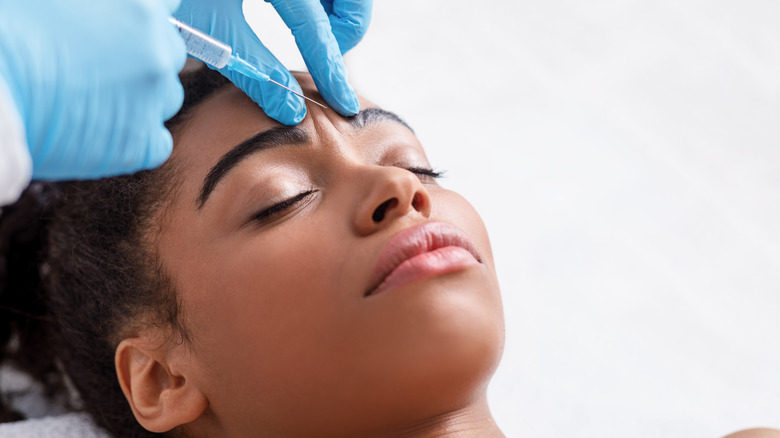TikTok Is Buzzing With Questions About Filler Migration. How Common Is It Really?
With over 30 million views, #fillermigration has been trending on TikTok lately, with users posting videos of cosmetic facial fillers that have seemingly "migrated" from their intended injection zones. This influx of content might make you wonder how common this phenomenon is, especially if you're considering some sort of cosmetic filler yourself (per Allure).
To start, dermal fillers are cosmetic injections, not unlike Botox, used to plump or smooth areas of the face (per Cleveland Clinic). As Simply Clinics explains, filler migration occurs when these dermal fillers move from their original injection zone, resulting in the distortion of facial features.
While this can occur at any injection site, it's most commonly seen around the lips. These fillers can migrate to the skin surrounding the mouth, creating a duck or shelf-like appearance above or below the lips (per AEDIT). Because filler procedures are literally intended to enhance the features that filler migrations affect, it's a truly unfortunate occurrence.
So, knowing what filler migration is, exactly how common is it?
Filler migration is actually a rare occurrence
Despite it becoming quite the trending topic on TikTok, filler migration isn't as common as it might appear on the app (per Allure). Jason Diamond, MD, a board-certified facial plastic surgeon located in Beverly Hills, explains that the increase in facial filler popularity, especially in the younger generation, has resulted in a higher demand for filler services.
"In turn, we see more inexperienced injectors providing the service, so now filler migration has gone from a very rare risk to a trending discussion TikTok. The more refined the technique/specialty skill/acute aesthetic judgment, the less the occurrence," he told Allure.
This is a sentiment echoed by Kalos Medical Spa, which explains that more clinics have begun offering cosmetic injections in the last decade, allowing underqualified injectors to pick up the needle. Poor placement technique, too much filler, and incorrect filler use can lead to migration, things that a well-trained professional will know how to avoid (per Simply Clinics).
Separately, inflammation can occur as your body's natural response to a foreign substance (via AEDIT). So, even if you have a really experience practitioner performing your injections, you might experience temporary inflammation and swelling at the injection site, but this is even less common than migration resulting from an inexperienced injector.
How to avoid filler migration
Knowing that filler migration is most often caused by inexperienced practitioners, the best solution is to research your chosen facility before committing to any injections. Admittedly, with so many alleged injectors present in the market, this research can be difficult to do.
As board-certified dermatologist Nancy Samolitis, MD told Allure, "There's all these certifications where people say, 'I'm a Certified Master Injector,' and it has zero meaning in the real world. And people [can] use fake photos. It could be really easy to get fooled by somebody who hasn't been doing it that long and doesn't have good training. The best thing you can do is ask lots of questions, because if they don't know, you're going to be able to know that they don't know."
Additionally, The American Society of Plastic Surgeons (ASPS) recommends choosing a plastic surgeon who has been board-certified by the American Board of Plastic Surgery (ABPS) or by the Royal College of Physicians and Surgeons of Canada. They also warn against alleged board certifications with "cosmetic surgery" in the title, as none of these are recognized by the American Board of Medical Specialties (ABMS).
Even though filler migration may seem scary, you can be reassured by the fact that it truly isn't as common as it might appear on TikTok. If you find yourself affected by this phenomenon, then know that treatment options are available to you.


